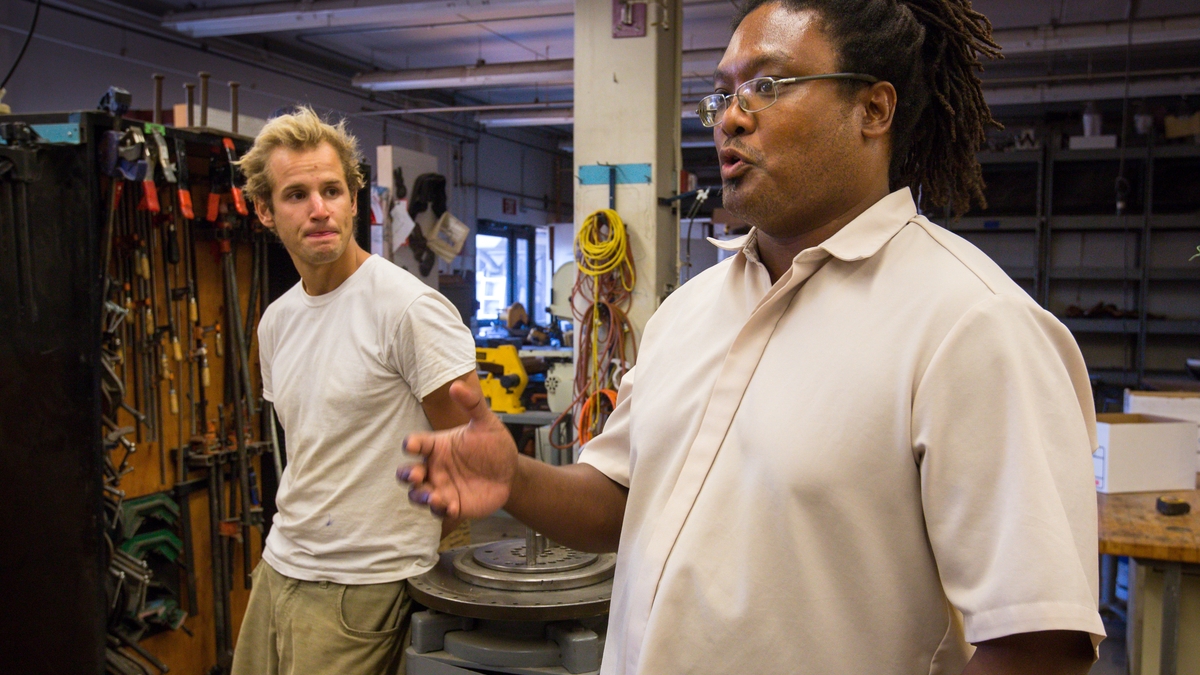Summer residency turns ASU students into rock stars

MFA graduate Eric Clausen listens as MFA student Alvin Huff talks about the Digital Stone Project in which they participated this past summer in Italy, while gathering in a sculpting lab in Tempe on Aug. 14. The project used robots to roughly sculpt digital sketches into blocks of marble. The artists still needed to do the fine precision work including sanding, polishing and buffing.
Michaelangelo once said that he never created sculptures; he simply chipped away at stone to reveal what was already inside.
Now two ASU students have given a millennial spin to that idea, using a digital program and robots that make it easier for artists to find what’s inside these slabs of rock.
This past summer Eric Clausen and Alvin Huff, graduate students in the School of Art in the Herberger Institute for Design and the Arts, participated in the Digital Stone Project, an international arts initiative based in Tuscany, Italy. It’s where they engaged with several master sculptors learning the time-honored tradition of carving marble, and where a state-of-the-art robot did most of the heavy lifting — or in this instance, carving.
The project used five- and seven-axis robots wielding diamond tool bits to roughly sculpt digital sketches into blocks of marble. The artists then do the fine precision work, including sanding, polishing and buffing their 300- to 400-pound marble sculptures.
“The use of a robot allowed me to experiment in a way where I didn’t have to deal with the laws of nature if the marble got cracked or chipped,” said Huff, who is working on his master’s degree in sculpting.
He used his time in Italy to sculpt “Shelter,” an abstract piece with ornate details.
“The robot also allows your abstract mind to create any object you can think of without having to pay for the materials, mess up your clothes or rough up your hands.”
The Digital Stone Project was founded in 2005 by sculptors who wanted to create a new way of working in stone by leveraging digital technologies. The monthlong residency is held each June at the foot of the mountains of the Garfagnana region of central Italy, where marble has been quarried for more than 2,000 years. These mountains provided the stone canvas for Michaelangelo’s iconic sculpture, “David.”
“The setting was inspiring because it was outside at the foot of these mountains and inside of a tent,” said Clausen, who earned his Master of Fine Arts degree this year. “I was completely removed from all of the trappings of a big city. It was just me and a slab of marble.”
His slab contained a small face tucked away inside a pair of exaggerated ears. He called it “Noise.”
Clausen and Huff were accompanied by Mary Neubauer, an art professor the Herberger Institute, as well as staff and students from a handful of other universities.
“One of the missions of ASU is to be interdisciplinary in our approach to almost everything, and that does include the arts,” said Neubauer, who also worked on a marble piece while in Italy. “We’re well-positioned to accept new technologies while still teaching the fundamentals. Students will need to have these skills in order to be employable.”
This was Neubauer’s second trip to Italy. She spent the month working on an intricate, ribbed ring sculpture dubbed “Monsoon.”
Her piece, as well as Clausen’s and Huff’s, was on exhibit for the month of July in Villa Strozzi in Florence, Italy, not far from the home of Michaelangelo’s “David.”